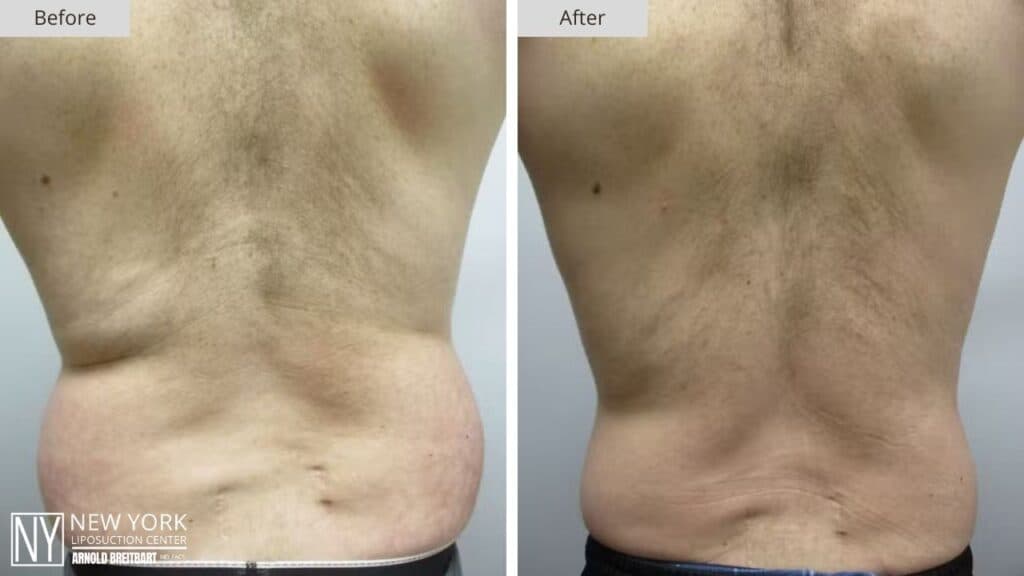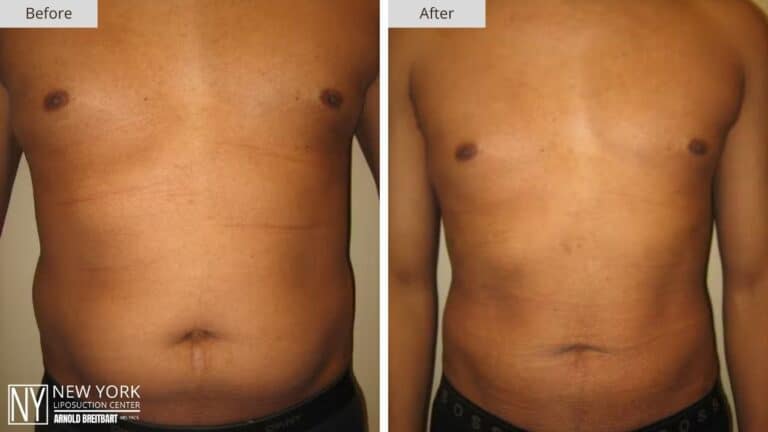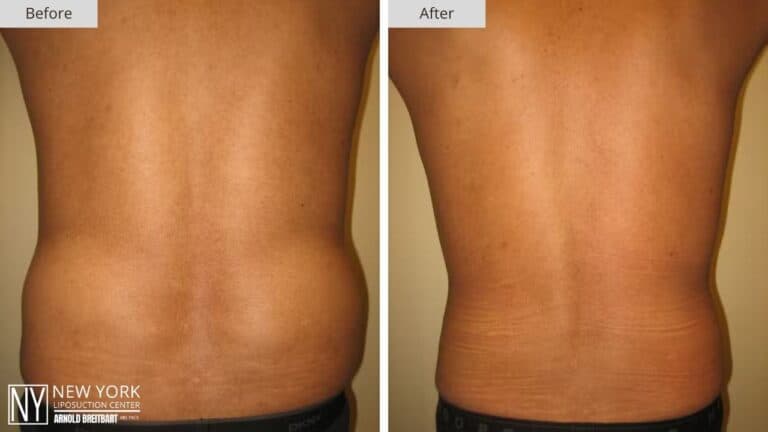Are you wondering if male liposuction is right for you? At the New York Liposuction Center, we’re here to help you find out.
More and more men are discovering how liposuction can help them achieve a leaner, more defined physique.
At the New York Liposuction Center, we specialize in male liposuction procedures designed to meet your unique needs. Whether you’re struggling with stubborn fat that won’t budge despite diet and exercise or looking to enhance your natural contours, liposuction can offer the solution you are looking for.
In this article, we’ll cover:
- The key areas of the body that benefit most from male liposuction
- What to expect during the procedure and recovery process
- How liposuction can help you feel more comfortable in your own skin
Let’s explore how male liposuction can improve your appearance and give you a greater sense of confidence!


Why Men Choose Liposuction
As men age, fat distribution in the body changes, often causing stubborn fat deposits to settle in areas that are hard to target with regular exercise. Whether it’s the abdomen, love handles, chest, or chin, many men find that these fat deposits just won’t budge.
Liposuction for men addresses these areas and provides a sculpted, athletic look. Men who opt for liposuction are often looking to:
- Eliminate stubborn fat in problem areas that don’t respond to exercise
- Enhance muscle definition by removing excess fat around muscles like the abs and chest
- Achieve a more toned physique, improving overall body proportions
- Boost self-confidence by improving appearance and reducing excess fat
Common Areas Treated in Male Liposuction
I customize male liposuction to target specific areas where fat tends to accumulate. Some of the most common areas men focus on are:
Abdomen and Love Handles
The abdomen and flanks are two of the most common areas for male liposuction. Fat around the waistline can be particularly difficult to get rid of with exercise alone, especially when it comes to those stubborn love handles. Liposuction can help remove fat and contour these areas for a more defined, slimmer waist.
Chest
Gynecomastia is a condition where men experience excess breast tissue or fatty deposits in the chest area. I target unwanted fat with chest liposuction and remove excess glandular tissue if needed. This combination provides a flatter, firmer chest that complements the overall body structure.
Chin and Neck
Excess fat around the chin and neck can lead to a double chin, which can significantly affect your appearance. I can use liposuction to remove excess fat to create a more defined jawline and neck for a more masculine profile.
Back
Fat on the back, particularly in the upper back and flanks, can be difficult to target with conventional exercise. Liposuction can help smooth out the contours of the back to improve overall body symmetry for a toned, athletic look.
Thighs
Some men experience fat accumulation on the thighs, particularly on the inner or outer thigh area. I can use liposuction to sculpt and slim the thighs and help you achieve more defined legs.
Abdomen
For many men, fat accumulation in the abdominal area, particularly the lower abdomen, can be especially stubborn. Liposuction can provide significant improvement, leaving a flatter, more toned stomach.
Male Liposuction Case Study
This 37-year-old male was in good overall shape but had developed stubborn fat around his abdomen and flanks that made him feel less confident. Like many men, he noticed that weight gain in his midsection became more pronounced with age, and it was increasingly difficult to tone this area through diet and exercise alone.
He wanted a more sculpted, athletic look that still felt natural and proportional.

Why SmartLipo Was the Right Choice
SmartLipo was ideal for this case because of its ability to remove fat while also tightening the skin. This laser-assisted technique uses heat to melt fat before it is suctioned out, which leads to less bruising and a smoother recovery. It also helps stimulate collagen, giving the skin a firmer appearance afterward.
For men, SmartLipo allows for precise sculpting rather than just volume reduction. This is especially important in the love handle and abdominal areas, where patients often want to reveal muscle tone without looking overdone.
Procedure Overview
The procedure was performed under local anesthesia. Small incisions were made in hidden areas near the waistline. A laser fiber was inserted to gently melt the fat, and then a narrow cannula was used to remove the fat from the abdomen and flanks.
This session focused on slimming the waistline and flattening the stomach while keeping the results smooth and natural. The patient returned home the same day and resumed light activity within a few days.
Results After Ten Months
At the ten-month follow-up, the improvement was clear. His abdomen is flatter, the love handles are reduced, and his entire midsection has a more defined and masculine shape. The result is balanced and subtle, making him look fit without looking surgically enhanced.
A Strong Option for Men Seeking Contour
This case shows how male liposuction with SmartLipo can address common problem areas while preserving a natural look. For men who want visible slimming with minimal downtime, this approach offers excellent results with long-term satisfaction.

The Liposuction Procedure
The male liposuction procedure is very similar to that used for women but is designed to address the specific concerns that men face when it comes to fat distribution. Here’s what you can expect:
Consultation
Your journey begins with a one-on-one consultation at the New York Liposuction Center, where we will discuss your goals, assess your current body shape, and decide on the best treatment areas. We’ll also review your health history to be sure that liposuction is the right option for you.
Anesthesia
Depending on the extent of the procedure and the treatment areas, I typically perform liposuction for men under local anesthesia with sedation or general anesthesia.
The Procedure
During the procedure, I insert a small, thin cannula (tube) through tiny incisions. I use the cannula’s gentle suction to remove unwanted fat from targeted areas. Then, I carefully sculpt the fat to create a smoother, more defined contour. The procedure usually takes between 1 and 3 hours, depending on how many lipo areas I’m treating.
Recovery
Recovery after male liposuction is relatively quick compared to more invasive procedures. Most men can return to light activities within a few days. Swelling and bruising are common in the first week, but these side effects will subside gradually. We recommend a compression garment to support healing and minimize swelling.
- First Week: Expect mild swelling and discomfort, which can be managed with prescribed pain medications. You’ll need to rest and avoid strenuous physical activity.
- Two to Four Weeks: Many men can return to work within a week or two, but exercise and heavy lifting should be avoided for at least 4 weeks.
- One to Three Months: Final results begin to take shape as the swelling completely goes away. You will notice a more defined and contoured body shape.


Combining Liposuction with Other Procedures
In some cases, men may choose to combine liposuction with other cosmetic procedures for more comprehensive results. For example, combining liposuction with a tummy tuck or muscle contouring can improve the final outcome.
If you’re considering combining liposuction with another procedure, it’s essential to discuss your goals with us during your consultation. We’ll help you understand how combining treatments can affect your recovery time and results.
Is Male Liposuction Right for You?
If you have areas of stubborn fat that don’t respond to diet and exercise, liposuction could be the solution. The ideal candidate for liposuction is someone who:
- Is in good overall health with a stable weight
- Has stubborn fat deposits that don’t respond to diet and exercise
- Wants to enhance their body proportions or improve muscle definition
- Has realistic expectations and understands the recovery process
At the New York Liposuction Center, we are committed to helping you achieve the body you are looking for. If you’re ready to take the next step and learn more about how male liposuction can work for you, schedule your lipo consultation today.
Schedule a Free Consultation
Fill out the form or at call us at (917) 809-7787 to schedule your free consultation with the New York Liposuction Center and get started on your liposuction journey.